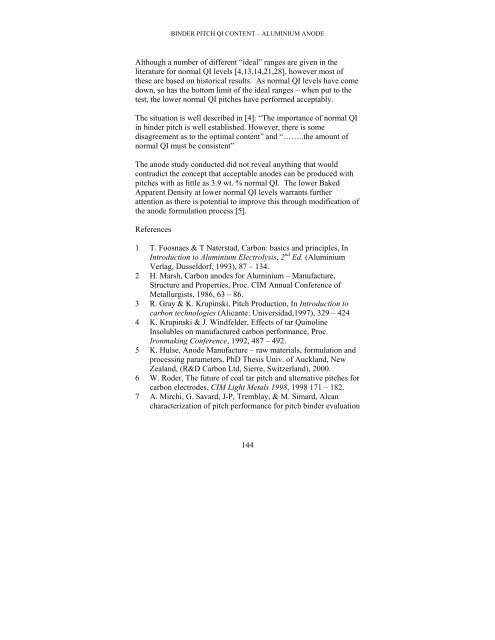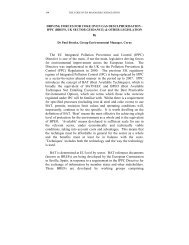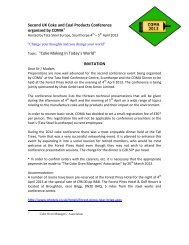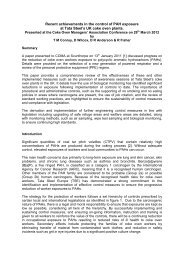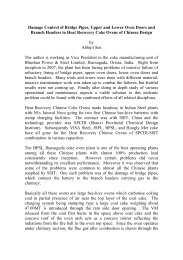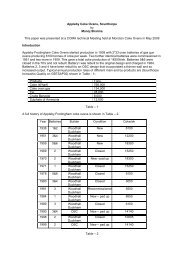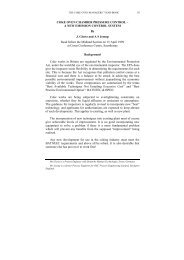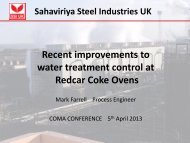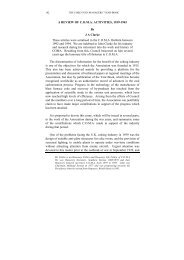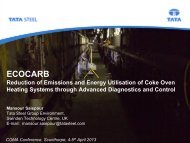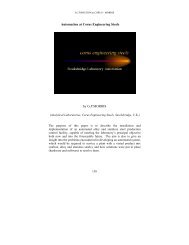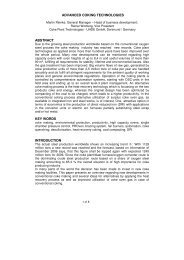the effect of binder pitch quinoline insolubles content - Coke Oven ...
the effect of binder pitch quinoline insolubles content - Coke Oven ...
the effect of binder pitch quinoline insolubles content - Coke Oven ...
Create successful ePaper yourself
Turn your PDF publications into a flip-book with our unique Google optimized e-Paper software.
BINDER PITCH QI CONTENT – ALUMINIUM ANODE<br />
Although a number <strong>of</strong> different “ideal” ranges are given in <strong>the</strong><br />
literature for normal QI levels [4,13,14,21,28], however most <strong>of</strong><br />
<strong>the</strong>se are based on historical results. As normal QI levels have come<br />
down, so has <strong>the</strong> bottom limit <strong>of</strong> <strong>the</strong> ideal ranges – when put to <strong>the</strong><br />
test, <strong>the</strong> lower normal QI <strong>pitch</strong>es have performed acceptably.<br />
The situation is well described in [4]: “The importance <strong>of</strong> normal QI<br />
in <strong>binder</strong> <strong>pitch</strong> is well established. However, <strong>the</strong>re is some<br />
disagreement as to <strong>the</strong> optimal <strong>content</strong>” and “……..<strong>the</strong> amount <strong>of</strong><br />
normal QI must be consistent”<br />
The anode study conducted did not reveal anything that would<br />
contradict <strong>the</strong> concept that acceptable anodes can be produced with<br />
<strong>pitch</strong>es with as little as 3.9 wt. % normal QI. The lower Baked<br />
Apparent Density at lower normal QI levels warrants fur<strong>the</strong>r<br />
attention as <strong>the</strong>re is potential to improve this through modification <strong>of</strong><br />
<strong>the</strong> anode formulation process [5].<br />
References<br />
1 T. Foosnaes & T Naterstad, Carbon: basics and principles, In<br />
Introduction to Aluminium Electrolysis, 2 nd Ed. (Aluminium<br />
Verlag, Dusseldorf, 1993), 87 – 134.<br />
2 H. Marsh, Carbon anodes for Aluminium – Manufacture,<br />
Structure and Properties, Proc. CIM Annual Conference <strong>of</strong><br />
Metallurgists, 1986, 63 – 86.<br />
3 R. Gray & K. Krupinski, Pitch Production, In Introduction to<br />
carbon technologies (Alicante: Universidad,1997), 329 – 424<br />
4 K. Krupinski & J. Windfelder, Effects <strong>of</strong> tar Quinoline<br />
Insolubles on manufactured carbon performance, Proc.<br />
Ironmaking Conference, 1992, 487 – 492.<br />
5 K. Hulse, Anode Manufacture – raw materials, formulation and<br />
processing parameters, PhD Thesis Univ. <strong>of</strong> Auckland, New<br />
Zealand, (R&D Carbon Ltd, Sierre, Switzerland), 2000.<br />
6 W. Roder, The future <strong>of</strong> coal tar <strong>pitch</strong> and alternative <strong>pitch</strong>es for<br />
carbon electrodes, CIM Light Metals 1998, 1998 171 – 182.<br />
7 A. Mirchi, G. Savard, J-P, Tremblay, & M. Simard, Alcan<br />
characterization <strong>of</strong> <strong>pitch</strong> performance for <strong>pitch</strong> <strong>binder</strong> evaluation<br />
144


